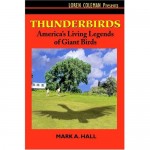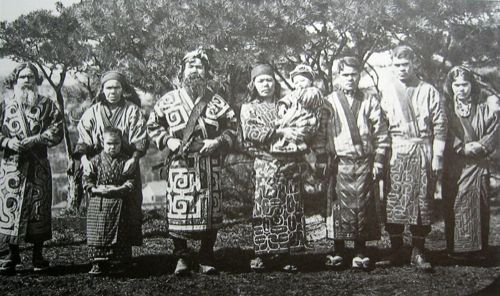
Thunderbirds, earthquakes, and tsunamis…
March 11, 2011

Thunderbirds, earthquakes, and tsunamis…
On March 11, 2011, a 33 feet tsunami has reportedly killed hundreds of people as it swept over Japan’s northeastern coast after the country’s biggest earthquake in recorded history. The 8.9 magnitude megaquake caused a huge wave that hit the port of Sendai city, sending ships crashing into the shore and carrying cars and buildings through streets. News agencies report a ship carrying around 100 was swept away by the tsunami. The quake also rocked the capital, Tokyo, which was among the cities shaken by at least 19 subsequent aftershocks. Mass evacuations are taking place after tsunami warnings were issued for the entire Pacific coast. The tsunami will hit Hawaii about 7 a.m. local time.

Ainu, the indigenous people of Japan
It is amazing what Thunderbird folklore may tell us about past tsunamis, says Ruth Ludwin, a University of Washington scientist. Her research has found that Thunderbird and other cryptid stories and traditions “could relate to a large Seattle fault earthquake around A.D. 900 and specific eyewitness accounts linked to a mammoth 1700 earthquake and tsunami in the Cascadia subduction zone.”
At 9PM on January 26, 1700 one of the world’s largest earthquakes occurred along the west coast of North America. The undersea Cascadia thrust fault ruptured along a 680 mile length, from mid Vancouver Island to northern California in a great earthquake, producing tremendous shaking and a huge tsunami that swept across the Pacific.
The Cascadia fault is the boundary between two of the Earth’s tectonic plates: the smaller offshore Juan de Fuca plate that is sliding under the much larger North American plate.
The earthquake also left unmistakable signatures in the geological record as the outer coastal regions subsided and drowned coastal marshlands and forests that were subsequently covered with younger sediments.
The recognition of definitive signatures in the geological record tells us the January 26, 1700 event was not a unique event, but has repeated many times at irregular intervals of hundreds of years. Geological evidence indicates that 13 great earthquakes have occurred in the last 6000 years.
Oral traditions of many Native American tribes describe what is interpreted as this huge earthquake and tsunami destroying coastal villages throughout what is now northern California, Oregon, Washington and southern British Columbia.
“There was a shaking, jumping up and trembling of the earth beneath, and a rolling up of the great waters.”
So says an ancient tale told to generations of Quilleute and Hoh Indians. Variations of this saga of an epic battle between the Thunderbird and the Whale are found among Pacific Northwest Tribes from Vancouver Island to Oregon’s Tillamook tribe.
It’s clear now that the stories document a massive earthquake and tsunami that hit the Northwest before the arrival of European settlers. But because the tales were treated as myths, it wasn’t until the early 1990s that one researcher recognized their value for the study of earthquakes.
“These stories just bristle with information,” said Ruth Ludwin, a seismologist at the University of Washington. In addition to using the tools of modern science and technology to study earthquakes, Ludwin has spent considerable effort looking into the tribes’ oral histories of these events.
Popular descriptions of earthquakes have always been an important resource for seismologists.
Ludwin and others have identified previously unknown quakes from scouring 19th century news clippings or other reports. Tribal lore had been a largely untapped resource, she said, because much of it had been lost to time and the information is often disguised.
“When I first started looking into the tribal histories, I was looking for statements that said something like ‘the ground shook’ or ‘the land slid’ or that sort of thing, direct descriptions,” Ludwin said. But this isn’t the way the tribes described things, she said. Major, traumatic events were described in the rich tradition of tribal mythology.
“It’s not trivial information,” Ludwin said. Once you dig deep enough and begin to understand the patterns and symbols conveyed by the words and sentence structures, she said, an astonishing amount of descriptive data begins to emerge. Read more at “Prehistoric and Historic Tsunamis.”
Read Ruth Ludwin’s complete paper, “Pacific Northwest Earthquakes: Evidence in Native Myth and Tradition.”
Starting in the early 1990s, [Ruth] Ludwin [a seismologist at the University of Washington] began searching for Native American descriptions of the event.
“Along the way, I picked up a lot of stories about landslides,” she said. But she couldn’t find anything that seemed to match the 1700 event, until she took a closer look at the story of Thunderbird and Whale.
“It’s a story of the underworld versus the over-world,” Ludwin said.
The Whale was a monster, killing other whales and depriving the people of meat and oil. The Thunderbird, a benevolent supernatural being, saw from its home high in the mountains that the people were starving. The great bird soared out over the coastal waters, then plunged into the ocean and seized the Whale.
A struggle ensued first in the water, the tribal tale says. “The waters receded and rose again. Many canoes came down in trees and were destroyed and numerous lives were lost.”
The Thunderbird eventually succeeds in lifting the evil Whale out of the ocean, carrying it “high into the air (and then) dropping it to the land surface at Beaver prairie. Then at this place there was another great battle.”
Ludwin, borrowing tools from anthropology and linguistics, was able to sort out statements meant to convey traditional wisdom or perspective from the statements that seemed to refer to actual, witnessed events.
“A picture began to emerge that looked a lot like what you’d expect from a major quake,” she said. One tribe even had what sounds like an explanation for aftershocks, noting Whale had a son, Subbus, who took Thunderbird several more days to locate and kill. The earth-rumbling struggle persisted, but eventually Subbus was subdued.
“I can’t say for certain this was the 1700 event, but it sure sounds like it,” Ludwin said. “You hear the same story from tribes all along the coast.”
She intends to continue trying to piece all these oral histories together to see if these descriptions offer scientists today any new information. It’s a technique seismologists have used for a long time, before they had instruments to give them hard numbers.
“Even into the 1960s, the best information we got was reported by ‘human seismometers,'” Ludwin said.

Mark A. Hall’s 2004 book Thunderbirds: America’s Living Legends of Giant Birds discusses large cryptid avian tales from Native peoples that these scientists might wish to re-examine.
About Loren Coleman
Loren Coleman is one of the world’s leading cryptozoologists, some say “the” leading living cryptozoologist. Certainly, he is acknowledged as the current living American researcher and writer who has most popularized cryptozoology in the late 20th and early 21st centuries.
Starting his fieldwork and investigations in 1960, after traveling and trekking extensively in pursuit of cryptozoological mysteries, Coleman began writing to share his experiences in 1969. An honorary member of Ivan T. Sanderson’s Society for the Investigation of the Unexplained in the 1970s, Coleman has been bestowed with similar honorary memberships of the North Idaho College Cryptozoology Club in 1983, and in subsequent years, that of the British Columbia Scientific Cryptozoology Club, CryptoSafari International, and other international organizations. He was also a Life Member and Benefactor of the International Society of Cryptozoology (now-defunct).
Loren Coleman’s daily blog, as a member of the Cryptomundo Team, served as an ongoing avenue of communication for the ever-growing body of cryptozoo news from 2005 through 2013. He returned as an infrequent contributor beginning Halloween week of 2015.
Coleman is the founder in 2003, and current director of the International Cryptozoology Museum in Portland, Maine.
Filed under Books, Breaking News, Cryptomundo Exclusive, CryptoZoo News, Cryptozoologists, Cryptozoology, Folklore, Thunderbirds, Winged Weirdies